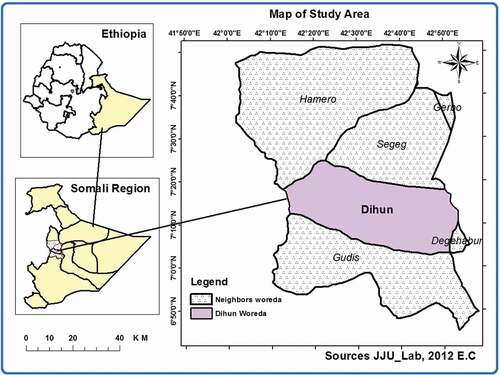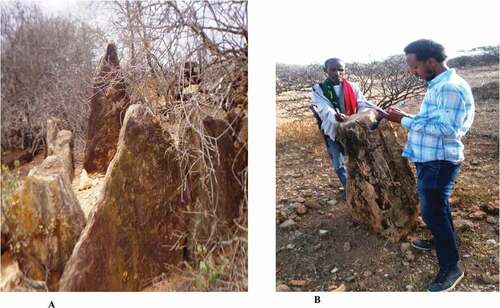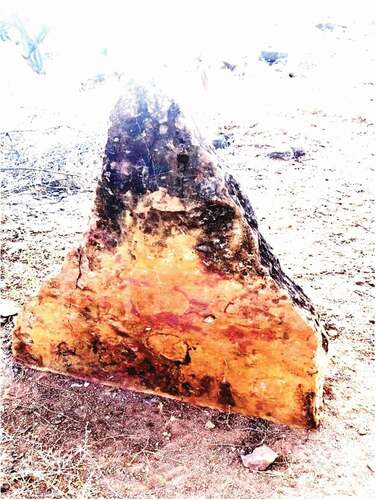Abstract
Ethiopia is gifted with various heritage resources, and it has registered its different types of heritage as a world heritage site. The megalithic culture in Ethiopia comprises dolmens, tumuli, and steles which are widely dispersed across the country. Though, the Somali Regional State is rich in natural, cultural, and historical heritage sites scholars have not yet given the attention it deserves. In this regard, the Derbi Belanbel Stele site is among them. Accordingly, this study proposed to explore the steles of the Derbi Belanbel site of Duhun woreda Somali region, Ethiopia. The study employed an exploratory research design and a qualitative research approach to investigating the historical value of the steles of Derbi Belanbel, to assess the shape, style, and height of Derbi Belanbel steles and challenge and prospects of sustaining the steles in the study area. Purposive and snowball sampling techniques were used to choose key informants who have beneficial knowledge, experience, and link with the heritage site. Data were gathered via personal observation, focus group discussion, semi-structured interviews, and document analysis. Concerning data analysis, a thematic data analysis technique was employed. The results of this study revealed that the steles of the Derbi Belanbel site have a historical value having different shapes and heights that could inspire further archaeological and historical research. However, due to poor preservation and conservation practice, some of the steles are on the verge of deterioration or change of their original nature.
PUBLIC INTEREST STATEMENT
Megalithic heritage sites are invaluable assets that have multidimensional values: historic, cultural, tourism, architecture, and others. The megalithic culture in Ethiopia comprises dolmens, tumuli, and steles which are widely dispersed across the country. The Derbi Belanbel site has the potential of tangible cultural Heritage but they are not well studied. Moreover, Derbi Belanbel’s steles are various in shape and heigh. However, this heritage site suffers due to a lack of awareness from the society and the government, poor preservation, and conservation practice which have the effect of deteriorating it or change of the stele’s original nature.
1. Introduction
The word heritage is defined by various scholars and institutions.Footnote1 Due to this reason, it has no universal meaning. According to Nuryanti, heritage is a comprehensive idea that alludes to something we gained from the past age (Nuryanti, Citation1996). It is a representative establishment whereupon a feeling of having a place is laid. It can be defined as a material testimony of identity (Park, Citation2010). A heritage site stands for a particular spot, which can address a broader or smaller spatial scope. As Ahmed stated, it is a very dynamic concept that includes both tangible and intangible elements (Ahmad, Citation2006). According to Park (Citation2010), heritage is a representative establishment whereupon a feeling of having a place is laid. It can be determined as material evidence of identity. Besides, it has natural and cultural heritage values (Boon et al., Citation2014).
The Ethiopian megalithic culture has been examined subsequently in the early years of the 20th century (Anfray, Citation1982). The literature on Ethiopia’s megalithic tradition also reveals a broader spread, such as the “Ella” stone platforms in Mursiland, Southwestern Ethiopia (Clack & Brittain, Citation2010). However, the task of systematic surveys and studies seems to have been carried out relatively less than the problem demands (Derara, Citation2008).
According to Grant, in Ethiopia archaeologists have revealed the megalithic monuments discovered across the country and considered by some as a land of megalithic culture (Grant, Citation2006). It comprises tumuli, stele, and dolmens which are widely dispersed all over the country. The stone monuments found in Ethiopia range from undecorated monoliths to elaborately dressed phallic and figurative stele. Some stele sites were cemeteries and include daggers, spearheads, geometrics, and zoomorphic representations (Joussaume, Citation2012, Citation1987, Citation1974).
The tradition of erecting stele has a long history and is common in Ethiopia. Many steles are erected in different parts of the country for different purposes such as for the spiritual purpose, to indicate the rulers’ tomb, to represent ideas or concepts (Anfray, Citation1982). Among those, the stele of Axum is erected around the 4th century A.D. and the Tiya stele are show the long experience of the Ethiopian in erecting steles (Grant, Citation2006).
The amount of research on megalithic culture in Ethiopia is, for the most part, inadequate. Archaeological investigations, on the other hand, have strengthened our understanding of the category of megaliths and their distribution across the country. Inventory study in the Atsebi Wemberta district (Aytenew, Citation2008), in the Gurage highlands in 2006, archaeological surveys of megalithic sites in the Chalba-Tutti of Gedeo Zone (Debebe, Citation2006), and ethnoarchaeological inquiry of megalithic tradition in Hadiya in Southern Ethiopia (Melesse, Citation2009), archaeological study of megalithic sites in Aksum and Shire areas of northern Ethiopia (Teka, Citation2010), recent advances on the archaeological exploration of the Islamic heritage in Eastern Ethiopia, Monitoring Islamic Archaeological Landscapes in Ethiopia Using Open-Source Satellite Imagery (Khalaf & Insoll, Citation2019), and Material Cosmopolitanism: The Entrepot of Harla as Islamic Gateway to Eastern Ethiopia (Insoll, T., et al., Citation2021) are among them. However, the author of this paper is unable to find works of literature dealing with megaliths in the Somali region.
Moreover, Ethiopia is endowed with numerous heritage resources, and it has registered its different types of heritage as world heritage sites. A considerable amount of research has been done on the country’s heritage sites found in regions north, central, and southern parts of the country (Finneran, Citation2013). Though the Somali Regional State is rich in natural, cultural, and historical heritage sites scholars have not yet given the attention it deserves. Scholars who have developed an interest in the study of archaeological and historical sites in eastern Ethiopia in recent years focused only on the areas located between the historic city of Harar, Dire Dawa, and its environs.
However, there is still an invaluable heritage, which is not explored. In this regard, the Derbi Belanbel Stele site is among them. It is a potentially rich essential heritage of a long time. However, it is not a subject of sound studies. Accordingly, this study proposed to explore the historical value of the Derbi Belanbel Stele, assess the shape and length of the Derbi Belanbel Stele. Finally, the study aimed to explore the challenges and prospects of sustaining the stele site. Consequently, the study addressed the following questions:
What historical significance does the Derbi Belanbel stele hold?
What are the shapes and heights of the major Derbi Belanbel Steles?
What are the challenges and prospects for preserving Derbi Belanbel’s steles?
2. Materials and methods
2.1. Description of the study area
This article presents the steles of Derbi Belanbel, in Ethiopia. It results from a survey carried out in 2018. This survey resulted in the findings of different types of archaeological remains, including the ruined mosque, houses, and different buildings. However, this article is mainly concerned with the steles of the Derbi Belanbel historical and cultural heritage site.
The site is in the Somali Region, one of the ten regional states in Ethiopia. Somali Region is in the south-eastern corner of Ethiopia, bordering Djibouti to the north, Somalia to the east and northeast, and Kenya to the south. Oromia Region (Ethiopia) forms its western border; the Afar Region lies to the northwest (Pankhurst & Assefa, Citation2008; Teshale, Citation2020).
Derbi Belanbel steles are in Duhun (also named Dihun) woreda (district) of Nogob Zone, Somali National Regional State of Ethiopia (see ). Nogob Zone is one of the eleven Zones of the Somali region (Teshale, Citation2020). The site is located about 360 km from Jigjiga the capital of the Somali region in Ethiopia towards the south and about 10 km from the nearby town Duhun. Duhun woreda has a longitude and latitude of 7°13ʹN42°41E and an elevation of an average of 859 meters above sea level. It covers a total area of 1925.6 km2. Ecologically, it is characterized by dry kola (dry hot) 98.64% and 1.36% Dry kola (very dry hot). The annual average rainfall of the woreda is 538.3 mm (Ejara, Citation2008).
Duhun woreda is bordered on the east by Gerbo, on the west by Ayun, on the south by the Shebelle zone (East Ime and Abaararow woredas), on the northwest by Erer zone (Hamero woreda) and on the northeast by Segeg woreda (Somali Regional State Bureau of Finance and Economic Development, Citation2019). According to participants, Duhun was favourable for an agricultural practice where the people used to cultivate rather oddly teff and sorghum because the area had received abundant rainfall. On the other hand, stock in the form of cattle, camels, sheep, and goats thrive in the present day, and therefore for sure did so in the past.
2.2. Research design and approach
This study employed an exploratory design. According to Cuthill, the exploratory design is carried on about a research problem when there are insufficient or no prior reports to cite to or rely upon to anticipate a result. The emphasis is on the acquisition of brainstorms and intimacy for future study or attempted when research problems are in a preliminary phase of the study (Cuthill, Citation2002). On the other hand, an exploratory research design is recommended for researchers who research in which not enough information was made available so far (Cohen, Manion & Morrison, Citation2011; Kothari, Citation2004). To this end, this study used an exploratory research design to carry out the preliminary study on the Derbi Belanbel stele site located at Duhun Woreda.
On the other hand, the choice of research approaches relies on the type of investigation and the objectives proposed to be attained. Consequently, this study deployed a qualitative research approach (Cohen et al., Citation2011; Dawson, Citation2002; Kothari, Citation2004) to discuss the Derbi Belanbel stele site. Moreover, qualitative research emphasizes researching and realizing the entailment which an individual or group of people attribute to a social or human problem (Creswell, Citation2014). This approach enables the researcher to comprehend issues by investigating them in their specific context and the meaning that individuals bring to them (Denzin & Lincoln, Citation2005). Thus, this research method was picked out for obtaining in-depth data from participants of the study.
2.3. Study population
Study population pertains to the total group of people, events, or things of interest that the researcher’s program to examine (Majid, Citation2018; Sekeran, Citation2003). Qualitative research demands an attentive selection of the study population from whom the researcher proposes to get data. For this reason, the researcher first decided whom he should consult to gather reliable and valid information. Accordingly, the researcher selected a local governor, elders, and employees of the Culture and Tourism Office of the Somali region, Ethiopia. The administrative Office of Duhun Woreda facilitated the selection of knowledgeable participants.
2.4. Sample size and sampling technique
It was not feasible to collect data from the whole population living in the woreda and selection of the sample was inevitable. A non-probable sampling technique was employed to select participants from the objective population for its appropriateness for qualitative research. On nonprobability sampling, subjective methods are used to decide which elements are included in the sample (Cohen et al., Citation2011; Lavrakas, Citation2008; Sekeran, Citation2003). Especially, both purposive and snowball sampling techniques were used to choose the participants of the study. There were certain standards employed while using these sampling techniques. These include knowledge, long-time dweller and experience, a strong connection with the heritage site, and the willingness to take part in the study. A total of twenty individuals actively participated in the current study. Nine persons were involved in the Focus Group Discussion (FGD) and eleven more persons were interviewed for additional information. The reason the participants were limited to twenty was due to the information saturation at that level (Dawson, Citation2002; Kumar, Citation2011). Going for more participants was deemed to be time-wasting and not relevant because no new insights were obtained after the twentieth participant.
2.5. Data collection tools
Relying on the type of investigation, data were gathered via field observation, semi-structured interviews, FGD, photography, and document analysis. All participants were asked several questions (see annex 1) dealing with the state of Derbi Belanbel stele heritage site as a cultural heritage. They were also asked about the historical value of steles, shape, challenges of sustaining the steles, and degree of deterioration in the site. The study data collection method was supported by cautious voice recording and capturing impressive photographs of the study area. The researchers conducted personal observation to measure the height, shape, and structure of the steles, gather additional information that helped to strengthen and triangulate the primary sources.
2.6. Data analysis method
Pursuing the data collection, an effort was made to transliterate the audio records and field notes of the research population. Besides, secondary sources were reviewed and employed to ensure and counter-check the primary data sources. Subsequently, thematic data analysis was employed (Dawson, Citation2002; Nowell et al., Citation2017) to examine the data. Thematic analysis is a qualitative research approach that can be applied to a variety of research problems and epistemologies. It’s a technique for finding, evaluating, arranging, explaining, and reporting patterns in a collection of data (Nowell et al., Citation2017).
3. Results and discussion
3.1. Historical value of Derbi belanbel stele site
The horn of Africa at large and the Somali inhabited areas have a rich archaeological heritage and seem to have a long history of settlement and use (Mire, Citation2015). Derbi Belanbel is among the heritage sites in the area. The word Derbi Belanbel is derived from the Somali language; Derbi means wall and Belanbel means the name of the plant on the site. There is a contradiction contradiction between written and oral sources is mainly focused on the origin of the civilization and who are Harlas? Oral traditions attested Harla to different peoples mainly the Somali, Oromo, and Harari people. The period of civilization is another contradicting point between written and oral sources. Oral sources claimed the origin of the site to the 15th to 16th century. On the other hand, written sources stated the origin of Harla civilization to 12th to 13th century (Insoll, Citation2017). According to participants, the site is associated with the Harla civilization that existed in the area during the 15th to 16th centuries. The consideration of the site from the Harla civilizations is based on the evidence of historical records and archaeological remnants of the site which are similar to that of Harla village. The site includes a ruined mosque and ruined buildings with various steles, as noted by the author during fieldwork (see ,).
Figure 2. This is the ruined Stone built house at DerbiBelanbel, Photograph by author. During observation/ field research: 30/07/2018, Duhun
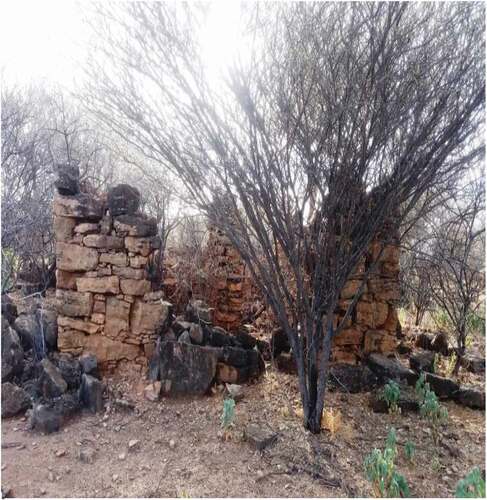
Figure 3. One of the steles of Derbi Belanbel located north of the ruined Mosque and South of ruined house. Photograph by author. During observation/ field research: 30/07/2018, Duhun
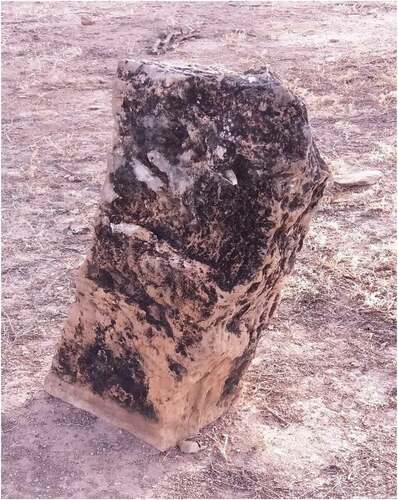
Figure 4. This is the ruined Mosque at DerbiBelanbel, a photograph taken from the southern direction. Photograph by author. During observation/ field research: 30/07/2018, Duhun
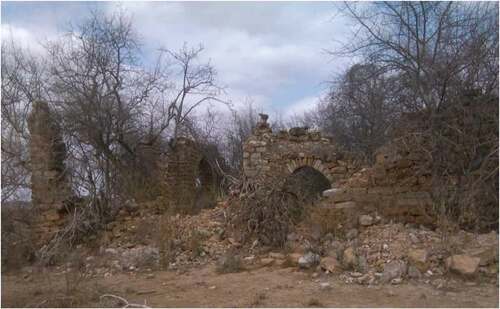
Most ruined towns lie across the frontier in the adjacent areas of Ethiopia, roughly halfway between the ancient port of Zeila and the walled town of Harar. The period of occupation of the towns was estimated to be the 15th and 16th centuries (González-Ruibal et al., Citation2017; Jorge, Citation2018, Citation2020). Thus, the stele of Derbi Belanbel might also be erected between the 15th and 16th centuries. However, the exact date of these steles is unknown.
Participants stated that, the site was a religious and trade centre where different merchants used to exchange their products. Informants stated that even two decades ago different coins were collected from the site. Besides, various remains of pottery and glass were also located on the site, which the researcher also confirmed the presence of fragmented pottery and glass that might be used as trading items. On the site, the researcher has observed several ruined houses, the remains of mosque buildings, and artefacts. Approximately fifty meters north of the mosque some steles are observed with different shapes and heights (see ). The steles of Derbi Belanbel have historical value to understand the megalithic culture of the area in the medieval history of Ethiopia and the Horn. To this end, the site might be used as evidence that there were permanent settlements and civilizations in the study area.
3.2. The steles of Derbi belanbel: shape and height
Megalithic sites and cemeteries are mostly known in the Horn of Africa literature from Ethiopia, which hosts sites like Aksum, Tiya, and Tutu Fela (Azais & Chambard, Citation1931; Joussaume, Citation1987, Citation1995, Citation2012, Citation2012; Phillipson, Citation1998). According to Sada Mire, there is also a tradition in Somaliland of carved gravestones and decorated stele, such as those found in Gidheys. As shown by the analysis of the Aw-Barkhadle site, the Horn of Africa custom of phallic gravestones (as seen in Tutitui and Tutu Fela) appears to have been practised contemporaneously with Islam. Furthermore, at Aw-Barkhadle, a grave marked by a stele bearing an Orthodox cross was discovered in situ, indicating that Christianity was practised here before or contemporaneously with Islam. Funerary chambers can be found in several megalithic burials in Somaliland (e.g., Gidheys). There are, however, striking parallels between Ethiopia, northern Kenya, Djibouti, and Eritrea. Solar and geometric signs, as well as schematic representations of animals, are engraved on the grave markers. The Saahil and Togdheer regions have the most elaborately decorated stelae cemeteries (Mire, Citation2015).
As much as the researchers has attempted to investigate, in Derbi Belanbel both the fallen and the sill standing steles counted 40. They are not placed in one spot. Steles identified around the southern remains stone-built houses especially near the big one built in the hammock; they form a cluster from some six in one place to two in another. The steles of Derbi Belabel have different heights. Among them as a preliminary study the researcher measured 5 of the standing steles. The steles shown below measured 1.13 meters and 1.30 meters (see ). Besides, the stele located others in the eastern direction of the site measured 1.65 meters, and 1.60 meters, and the tallest standing stele measured 2 meters located on the top area of the site. On the other hand, there are also fallen steles that need further archaeological studies.
Concerning shape and style, the structures are flat, rectangular, and conical in shape. There is a striking geometric similarity between these at Derbi Belanbel, and Tiya (see ) and around Dilla megalithic steles, located in the Guraghe Zone and Gedeo zone respectively Southern Ethiopia.
Figure 6. The photograph in “A” and “B” displaying images and represents the Derbi Belanbel Steles and “C” represents Tiya Stele displaying the engraved sword. The geometric similarity is interesting. During observation/ field research: 30/07/2018, (photo by author)
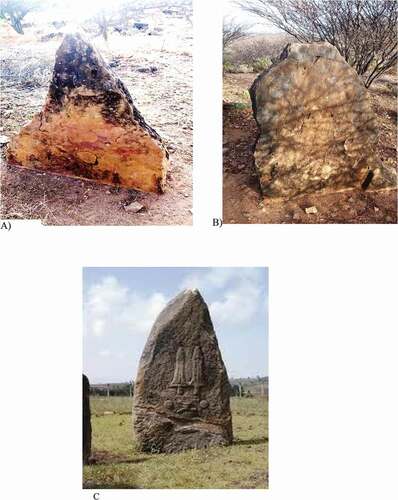
In general, the steles of Derbi Belanbel are a kind of stele erected without any engravings. They have a triangular shape and are sharp at the tips of the Stone. According to Joussaume, these types of Megalithic Stone are found in the Megalithic sites of Tiya (Joussaume, Citation2012). and 6 depict the triangular shape steles of Derbi Belanbel. However, it needs further archaeological and historical studies.
It has been indicated above those steles in Duhun woreda have different sort of shapes which majorly includes, triangular and rectangular. Besides, there are the traditions of erecting megalithic stones or steles throughout the country. Researchers asserted steles are one of the cultural heritages of the Southern Nations and Nationalities People Region (SNNPR). There are steles in Gedeo, Sidam, Gurage, Silte, Wolayita Zone, and Yeme special woreda and Konso woreda. Steles in those areas are different in shape, length, and size (Duff et al., Citation2018; Grant, Citation2006; Joussaume, Citation2012). Accordingly, this research asserted Derbi Belanbel’s steles are also one of the cultural heritages of the Somali region.
Some of the Derbi Belanbel steles are like Tiya steles in shape. The major distinction among the steles of Derbi Belanbel and Tiya is in the kind of engravings, decorations, and symbols they feature. For example, unlike the ones in Tiya, none of the structures in Derbi Belanbel features the symbol of a sword as shown in .
3.3. Challenges and prospects in sustaining the steles of Derbi belanbel
The researchers has identified the following challenges that are to a great extent repress the sustainability of the site. Derbi Belanbel faces a lot of challenges in managing its heritage assets. One of the key challenges is in developing a system or management that takes into consideration every stakeholder’s concern. Currently, there is no conservation management plan for Derbi Belanbel. Decision-making practise must be consistent to elevate the value of heritage assets and to safeguard its consistency with the principles and guidelines stated. There is also a lack of collaboration in terms of managing the assets.
Yet the bounded studies that have been carried on the Ethiopian megaliths were focused along highways and nearer to main towns. For similar reasons, the vast part of the hinterland of the country has remained un-surveyed (Derara, Citation2008). Because of such constraints, our knowledge about the distribution of the Ethiopian stele and rock arts is limited. Thus, the steles of Derbi Belanbel are also not well known.
Like in the rest of Africa, most of the rock arts in Ethiopia are found in open-air shelters and boulders in a precarious condition for their preservation (Hagos, Citation2011). The Derbi Belanbel steles are exposed to several alterations, which may affect deterioration. Together human-made and natural constituents could induce severe impairments to invaluable heritage sites and cause their sustainability doubtful (Cassar, Citation2009). In Africa, sustainable management of the heritage site is determined by its infant age (Mboya, Citation2009). The researcher observed that the same is true regarding heritage management in the Derbi Belanbel site.
Besides, the condition at the Derbi Belanbel stele site, which is a cultural and natural potential attraction site. Except for the serious care it gave to it, the sustainability of this crucial heritage spot is impossible. Currently, it is at the risk of eradication. According to participants, the absence of a responsible body to defend the site from human and animal-associated impairments exposed the heritage site at large and the steles to the specific to crumbling. They revealed that bunches of cattle are invariably relinquished towards the heritage site and its neighbourhood for pasturing which were observed by the author during the fieldwork. Moreover, the remains of the heritage site have been used by the local society for house construction.
Preceding studies carried on with sustainability of heritage places strongly urge that stakeholders’ (including local community) active engagement in heritage management plays a pivotal role in reducing the degree of heritage impairments (Aas et al., Citation2005; Gebreegziabher et al., Citation2019; Lennon, Citation2006).
This is a missing element in the study area and ensuring the sustainability of Derbi Belanbel steles would be hardly possible without raising awareness and ensuring the involvement of the residents. The lack of appropriate identification, documentation, conservation, and promotion of this important heritage site affects its sustainability. An inadequate stage of consciousness within the local people affects their sympathizing with the multifarious values of their heritage. These difficulties were hinted at in earlier research works (Chirikure et al., Citation2010), pointing out that inadequate institutional pertain and small community awareness of heritage sites ensue in the damage of numerous heritage assets.
Furthermore, the cultural and historical heritage of the area has not been adequately protected, developed, and used as a tourist attraction. According to Shultz et al., the tourism industry is complex and hyper-dynamic, constituted of a highly fragmented value chain. They also stated that the tourism industry covers travel organizers, accommodation providers, tourist offices, visitor attractions, and transport activities (Shultz et al., Citation2015). However, regarding Derbi Belanbel those all-value chains are not observed and there are also no tourist facilities. Furthermore, the quality of service is poor and unsatisfactory even for the local communities which host those historical and cultural sites. Because of the absence of an all-weather road, it takes 10–12 hours to arrive at Duhun town from Jigjiga city depending on the strength of the vehicle. This shows besides accommodation, let alone reaching into the site is challenging.
Besides, weak mutual support and coordination among tourism stakeholders were also observed as a major challenge. Although the researcher has observed, the site received little or no protection from the local level administration and the residents of the Duhun woreda. Informants asserted that adversely to its historical and cultural value the area is not given due consideration from the concerned stakeholders. According to participants, inhabitants of the area have persistently used the blocks of stones from the ruined heaps to construct their houses with no one from the local level administration prohibiting them from doing so. Therefore, natural factors like whirlwinds and lightning, heavy showers of rain and bushes, shrubs, and trees that have grown around the steles conjugated with anthropogenic causes would undoubtedly hasten the destruction of the historical site. This is a huge loss for the history and culture of the region. Generally, poor conservation of the potential resources and the absence of promoting them to the public are the main challenges of the Derbi Belanbel site.
As discussed before, the Derbi Belanbel’s heritage site is a very intriguing heritage having multi-faceted significance. It could be an epitome spot for upcoming archaeological and historical research works to cover the overhead mentions disputes. If the threat of tourism is well managed on the site, it could be a good place for tourism development in Duhun Woreda. Its steles, remnants, and topography or its cultural and natural heritage are attractive enough to visitors. This, in turn, could advocate tourism development in the area. Preserving the site and sustaining it to the coming generation, therefore, is a sturdy task. It demands serious consideration to protecting the site from relentless damages. Besides, it could be an epitome spot for upcoming archaeological and historical research works to cover the origin and date of the steles. Moreover, in the Somali region, there is a shortage of trained manpower at the woreda level that is crucial to the development of the tourism sector and management of the heritage of the study area.
Nevertheless, despite the above challenges, there are prospects, to conduct research, preserve and promote the historical and cultural site in question. One such opportunity is the presence of friendly communication between regional, zonal, and woreda level administrators and workers. Had it not been for the willingness and cooperation that received from all levels of administrators, the success that researchers have so far would have been a mere dream. The other prospect is the warm welcome and cooperation that the people of the woreda display whenever there is such a demand. Moreover, their readiness to protect and preserve historical and cultural sites will be fruitful if they are supported by the concerned stakeholder starting from the local to the federal level.
4. Conclusion
Oral sources claimed the origin of the site to the 15th to 16th century. On the other hand, written sources stated the origin of Harla civilization to 12th to 13th century (Insoll, Citation2017). According to participants, the site is associated with the Harla civilization that existed in the area during the 15th to 16th centuries. Rely on this it looks easy to assert that the contradiction among the written and oral sources concerning the origin and dwellers of the Derbi Belanbel site needs further archaeological study and dating system to know the exact age of the Derbi Belanbel cultural heritage site. It is important to note here that this site is very impressive for various reasons: various steles, ruins of a mosque, and ruins of houses are a living testimony regarding the history and culture of the area. This preliminary study asserted the steles of Derbi Belanbel has different shape and height having a historical value which is associated to the medieval history of Ethiopia and the horn.
Further, this heritage site suffers due to lack of awareness from the society and the government, poor preservation, and conservation practice which have the effect of deteriorating it or change of the stele’s original nature. The site has the potential of tangible cultural heritage, but they are not well studied. To protect and preserve the Derbi Belanbel steles the researcher put some recommendations to the concerning body first, urgent response should be given from the government and the society. Second, appropriate heritage management experts should be employed by the government and decentralize culture and tourism at the woreda level to conduct and handle the preservation and conservation of these cultural heritages. Besides, society should also be given awareness about the values of these heritages and the ways by which they can overlook these heritages as any cultural heritage management will not be operative without the involvement of society. Lastly, appropriate protection should be given for the site by applying proper study and research, starting from fencing the area. The sustainability of this heritage site is impossible unless immediate actions are undertaken to save it from distinction.
Acknowledgements
We would like to express our gratitude to Duhn Woreda Administration Office for its strong cooperation in facilitating field data collection on the site. Our sincere goes to Jigjiga University, research office for their support. We want to extend our earnest gratitude to all of the participants, who gave us much of their precious time debating on and forwarding their ideas on questions that arose for discussion. We also wish to extend our deep thanks to field guiders, for their pleasant cooperation during the data collection processes. We also thank both anonymous reviewers for their constructive comments.
Disclosure statement
No potential conflict of interest was reported by the author(s).
Additional information
Funding
Notes on contributors

Tesfamichael Teshale
Tesfamichael Teshale is a senior lecturer and researcher of History and Heritage Management under the college of social science and Humanities in Jigjiga University, Ethiopia. He is a PhD candidate at University of South Africa and currently working as a lecturer, researcher, and Research, publication, and technology transfer coordinator of the college of social science and humanities, Jigjiga University. He has conducted different research and published some articles in journals. He is also researching issues related to History, Heritage tourism, museum, Cultural anthropology, and Heritage Management in the Somali region, and eastern Ethiopia. His research concentrates on History, cultural/social anthropology, heritage tourism, heritage management, museum studies, indigenous conflict resolution, and accounting and finance.

Ahmed Abdulahi
Tesfamichael Teshale is a senior lecturer and researcher of History and Heritage Management under the college of social science and Humanities in Jigjiga University, Ethiopia. He is a PhD candidate at University of South Africa and currently working as a lecturer, researcher, and Research, publication, and technology transfer coordinator of the college of social science and humanities, Jigjiga University. He has conducted different research and published some articles in journals. He is also researching issues related to History, Heritage tourism, museum, Cultural anthropology, and Heritage Management in the Somali region, and eastern Ethiopia. His research concentrates on History, cultural/social anthropology, heritage tourism, heritage management, museum studies, indigenous conflict resolution, and accounting and finance.
Notes
1. Different institutions like the United Nations Economic, Scientific, and Cultural Organization (UNESCO), International Council on Monuments and Sites (ICOMOS), International Council of Museums (ICOM) defined heritage from different perspectives. See also; Ingegärd Eliasson, Igor Knez & Susanne Fredholm (2018) Heritage Planning in Practice and the Role of Cultural Ecosystem Services, Heritage & Society, 11:1, 44-69, DOI: 10.1080/2159032X.2019.1576428: https://doi.org/10.1080/2159032X.2019.1576428; International Council of Museums (ICOM), (2010). ICOM Missions. http://icom.museum/; International Council on Monuments and Sites (ICOMOS) (2016). Cultural Heritage, the UN Sustainable Development Goals, and the New Urban Agenda.; Bokova, I. (2012) “Preface”, in UNESCO, World Heritage: Benefits beyond borders, UNESCO and Cambridge University Press, Cambridge.; European Commission (2108). Innovation in Cultural Heritage—For an integrated European Research Policy ISBN 978-92-79-78,019-6 doi:10.2777/673,069
References
- Aas, C., Ladkin, A., & Fletcher, J. (2005). Stakeholder collaboration and heritage management. Annals of Tourism Research, 32(1), 28–16. https://doi.org/https://doi.org/10.1016/j.annals.2004.04.005
- Ahmad, Y. (2006). The Scope and Definitions of Heritage: From Tangible to Intangible. International Journal of Heritage Studies, 12(3), 292–300. https://doi.org/https://doi.org/10.1080/13527250600604639
- Anfray, F. (1982). LES STELE du DUD SHOA et SIDAMO. In Gizaw (Ed.), Annales D’ Ethiopie (Vol. 12, pp. 9–42). Gizaw Hilemariam’s Amharic translation of Anfray’s research on the stelae in Shoa and Sidamo.
- Aytenew, Y. (2008). An archaeological study of the megaliths of Atsbi Wemberta District and its environs[M.A. Unpublished thesis]. Department of History, Archaeology Unit, Addis Ababa University.
- Azais, R. P., & Chambard, R. (1931). Cinq années de recherches archéologiques en Ethiopie. Paul Geuthner.
- Boon, C., Teo, C., & Rita, N. (2014). Understanding cultural heritage visitor behavior: The case of Melaka as a world heritage city. Procedia - Social and Behavioral Sciences, 130, 1–10. https://doi.org/https://doi.org/10.1016/j.sbspro.2014.04.001
- Cassar, M. (2009). Sustainable heritage: Challenges and strategies for the twenty-first century. APT Bulletin. Journal of Preservation Technology, 40(1), 3–11. http://discovery.ucl.ac.uk./id/eprint/18790/1/18790.pdf
- Chirikure, S., Manyanga, M., Ndoro, W., & Pwiti, G. (2010). Unfulfilled promises? Heritage management and community participation at some of Africa’s cultural heritage sites. International Journal of Heritage Studies, 16(1–2), 30–44. https://doi.org/https://doi.org/10.1080/13527250903441739
- Clack, T., & Brittain, M. (2010). The’Ella’stone platforms in Mursiland, Lower Omo Valley, south-western Ethiopia. Antiquity, 84, 323. http://www.academia.edu/download/51652215/Clack-Brittains-EthiopiaAntiquity-2010pdf.pdf
- Cohen, L., Manion, L., Morrison, K., & Corporation, E. (2011). Research methods in education (7th ed. ed.). Abingdon, Oxon. https://doi.org/https://doi.org/10.4324/9780203720967
- Creswell, J. (2014). Research design: Qualitative, quantitative, and mixed methods approach. SAGE Publications, Inc.
- Cuthill, M. (2002). Exploratory Research: Citizen Participation, Local Government, and Sustainable Development in Australia. Sustainable Development, 10(2), 79–89. https://doi.org/https://doi.org/10.1002/sd.185
- Dawson, C. (2002). Practical research methods: A user-friendly guide to mastering research techniques and projects. How To Books Ltd.
- Debebe, A. (2006). Archaeological survey of Chalba-Tutti Megalithic sites in Gedeo-Zone[Unpublished M.A. thesis]. Department of History, Archaeology Unit, Addis Ababa University.
- Denzin, N., & Lincoln, Y. (2005). Introduction: The Discipline and Practice of Qualitative Research. In The Sage Handbook of Qualitative Research (3rd ed. ed., pp. 1–32). Sage Publications.
- Derara, W. (2008). On the Megalithic Sites of the Gurage Highlands: A Study of Enigmatic Nature of Engravings and Megalith Builders. EJOSSAH, VI(1 & 2), 6382. https://doi.org/https://doi.org/10.4314/ejossah.v6i1-2.72257
- Duff, A., Zena, A., Melesse, A., Wolff, J., Neill, O., & Shackley, M. (2018). Recent research on megalithic stele sites of the Gedeo Zone, Southern Ethiopia. Journal of Archaeological Science: Reports, 19,856–863. https://doi.org/https://doi.org/10.1016/j.jasrep.2018.03.034
- Ejara, H. (2008). Baseline Survey of 55 Weredas of PCDP Phase II. Addis Ababa.
- Finneran, N. (2013). Lucy to Lalibela: Heritage and identity in Ethiopia in the twenty-first century. International Journal of Heritage Studies, 19(1), 41–61. https://doi.org/https://doi.org/10.1080/13527258.2011.633540
- Gebreegziabher, A., Getaneh, S., & Aregu, Y. (2019). Sustaining Ethiopian heritage sites: The case of Gemate burial site in Dejen. Cogent Social Sciences, 5(1), 1603001. https://doi.org/https://doi.org/10.1080/23311886.2019.1603001
- González-Ruibal, A., Jorge, D. T., Franco, M. A., Ali, M. A., Shabelle, A. M., Barrio, C. M., & Aideed, K. A. (2017). Exploring long-distance trade in Somaliland (AD 1000–1900): Preliminary results from the 2015–2016 field seasons. Azania: Archaeological Research in Africa, 52(2), 135–172. https://doi.org/https://doi.org/10.1080/0067270X.2017.1328214
- Grant, C. (2006). Stones, Slabs, and Stelae: The Origins and Symbolism of Contemporary Oromo Burial Practice and Grave Art. Independent Study Project (ISP) Collection, 263. https://digitalcollections.sit.edu/isp_collection/263
- Hagos, T. (2011). The Ethiopian rock arts: The fragile resources, Authority For Research And Conservation Of Cultural Heritage.
- Insoll, T. (2017). First Footsteps in the Archaeology of Harar, Ethiopia. Journal of Islamic Archaeology, 4.2(2), 189–215. https://doi.org/https://doi.org/10.1558/jia.35273
- Insoll, T., Khalaf, N., MacLean, R., Parsons-Morgan, H., Tait, N., Gaastra, J., Beldados, A., Pryor, A. E., & Elvis, L. (2021). Material cosmopolitanism: The entrepot of Harlaa as Islamic gateway to Eastern Ethiopia. Antiquity, 95(380), 487–507. https://doi.org/https://doi.org/10.15184/aqy.2020.169
- Jorge, D. T. R. (2018). Against all odds: The history of archaeological research in Somaliland and Somalia. Northeast African Studies, 18(1–2), 271–310. https://doi.org/http://doi.org/10.14321/nortafristud.18.1-2.0271
- Jorge, D. T. R. (2020). Built on diversity: Statehood in Medieval Somaliland (12th-16th centuries AD). Anejos de NAILOS, Nº. 6, xx–xx. http://hdl.handle.net/10261/216279
- Joussaume, R. (1974). LeMegalithisme en Ethiopie: Monument funerares Protohistoriques du Harar. C.N. R.S.
- Joussaume, R. (1987). Dolmens for the Dead: Megalith Building throughout the World. Bastford Lit.
- Joussaume, R. (Ed.). (1995). Tiya – L’Éthiopie des mégalithes. Du biface à l’art rupestre dans la Corne de l’Afrique. Mémorie XI. Ministère des Affaires Étrangères, Ministère de la Coopération, Ambassade de France en Èthiopie. UNESCO, UPR 311 du CNRS.
- Joussaume, R. (2012). The Superimposed Cemeteries of Tuto Fela in Gedeo Country (Ethiopia), and Thoughts on the Site of Chelba-Tutitti. In Fauvelle-Aymar F.-X. (Ed.), Palethnology of Africa, Palethnology, 4, 87–110. http://www.palethnologie.org
- Khalaf, N., & Insoll, T. (2019). Monitoring Islamic Archaeological Landscapes in Ethiopia Using Open Source Satellite Imagery. Journal of Field Archaeology, 44(6), 401–419. https://doi.org/https://doi.org/10.1080/00934690.2019.1629256
- Kothari, C. R. (2004). Research methodology: Methods and techniques (2nd ed. ed.). New Age International Publishers.
- Kumar, R. (2011). Research methodology a step-by-step guide for beginners (3rd ed. ed.). SAGE Publications Ltd.
- Lavrakas, P. J. (2008). Encyclopedia of survey research methods (Vols. 1-0). Sage Publications, Inc. https://doi.org/https://doi.org/10.4135/9781412963947
- Lennon, J. (2006). ‘Cultural heritage management. In M. Lockwood, G. L. Worboys, & A. Kothari (Eds.), Managing Protected Areas: A global guide (pp. 448–473). Earthscan.
- Majid, U. (2018). Research fundamentals: Study design, population, and sample size. URNCST Journal. January10 2(1), https://urncst.com/index.php/urncst/article/view/161–7.10.26685/urncst.16
- Mboya, L. (2009). Communities versus heritage institutions/ professionals: The war of supremacy in the management of cultural heritage places? In sustainable management of cultural heritage places. Africa Cultural Heritage Organizations.
- Melesse, A. (2009). An ethnoarchaeological study of megalithic tradition among the Hadiya in Southern Ethiopia[Unpublished M.A. thesis]. Department of History, Archaeology Unit, Addis Ababa University.
- Mire, S. (2015). Mapping the Archaeology of Somaliland: Religion, Art, Script, Time, Urbanism, Trade and Empire March 2015. African Archaeological Review, 32(1), 111–136. https://doi.org/https://doi.org/10.1007/s10437-015-9184-9
- Nowell, L. S., Norris, J. M., White, D. E., & Moules, N. J. (2017). Thematic Analysis: Striving to Meet the Trustworthiness Criteria. International Journal of Qualitative Methods, 16(1), 160940691773384. https://doi.org/https://doi.org/10.1177/1609406917733847
- Nuryanti, W. (1996). Heritage And Postmodern Tourism. Annals of Tourism Research, 23(2), 249–260. https://doi.org/https://doi.org/10.1016/0160-7383(95)00062-3
- Pankhurst, A., & Assefa, G., Eds. (2008). Grass-roots justice in Ethiopia: The contribution of customary dispute resolution. Addis-Abeba: Centre français des études éthiopiennes. https://doi.org/https://doi.org/10.4000/books.cfee.471
- Park, H. (2010). Heritage tourism: Emotional journeys into nationhood.Annals of Tourism Research, 37(1), 116–135. https://doi.org/https://doi.org/10.1016/j.annals.2009.08.001
- Phillipson, D. W. (1998). Ancient Ethiopia: Aksum, its antecedents and successors. British Museum.
- Sekeran, U. (2003). Research methods for business: A skill-building approach (Fourth ed. ed.). John Wiley and Sons, Inc. https://doi.org/https://doi.org/10.1016/j.otsr.2010.03.025
- Shultz, C. J., Pestek, A., & Geroulis, E. (2015). Challenges and opportunities for the development of sustainable tourism in Bosnia And Herzegovina. Loyola University.
- Somali Regional State Bureau of Finance and Economic Development, (2019). Somali Regional State Settlements, BoFED GIS team.
- Teka, B. (2010). Archaeological inventory of the Megalithic sites of Aksum vicinity and Shire area(Unpublished M.A. thesis). Department of History, Archaeology Unit, Addis Ababa University.
- Teshale, T. (2020). Tourism potentials and challenges of the Somali region, Ethiopia. Journal of Tourism & Hospitality, 9, 447. https://doi.org/http://doi.org/10.35248/2167-0269.20.9.447
Annex 1:
Checklist to guide Interview and FGD
A. Protocol during interview with key informants
Title: Megalithic Heritage sites of Ethiopia: The case of Derbi Belanbel Steles in the Somali region
Date of interview: ___________
Place of interview: ________________________
Name of the Informant (Pseudonym): ____________________
Sex ______ Age _______
Name of site: _____________________________
Part I: The origin and the collapse of the historical and cultural centres context
When was the site originated?
What were the major factors contributed for the origin of the site?
What do oral traditions say as to the agency of the site?
What were their bases of livelihood?
What are the major factors for the collapse of the civilization?
Part II. Terminology issues
(6) What is the terminological meaning of Derbi Balanbal?
Part III. Contribution to the development of the tourism industry and in building the image of the Somali National Regional state
(7) How could you evaluate the site potential to the development of the tourism industry?
(8) What is the major remains and artifacts found on the site?
(9) What and how can you understand the historical values of the site?
(10) Is there any tourism related activity in relation with the site?
(11) Have government and other stakeholders consulted the community about the value of site?
(12) What do you think the future intervention must do to support preservation and conservation of historical and cultural heritages in the Somali region?
B. Check list to guide interview with local government officialsDate: ______________________ Place: __________________ Time: _______
What is the role of local government to support the preservation and conservation of historical and cultural sites?
Is there any dedicated office at woreda (district) administration level for historical, cultural and tourism related issues?
How could you explain the relationship between local government and other stakeholders such as local people?
Is there recent intervention by government to support reconstructing history, preservation, and conservation of historical cultural sites? If there, list types of intervention and its purpose
C. Focus Group Discussion
When was the site originated?
What were the major factors contributed for the origin of the site?
What do oral traditions say as to the agency of the two historical and cultural sites?
What were their bases of livelihood?
What are the major factors for the collapse of the civilization?
What is the terminological meaning of Derbi Balanbal?
What is the major remains and artifacts found on the site?
What and how can you understand the historical and cultural values of the site?
Is there any tourism related activity in relation with the site?
Have government and other stakeholders consulted the community about the value those historical and cultural site?
What are key factors affecting tourism development in the Somali region?
What do you think the future intervention must do to support preservation and conservation of historical and cultural heritages in the Somali region?
Thank You!

